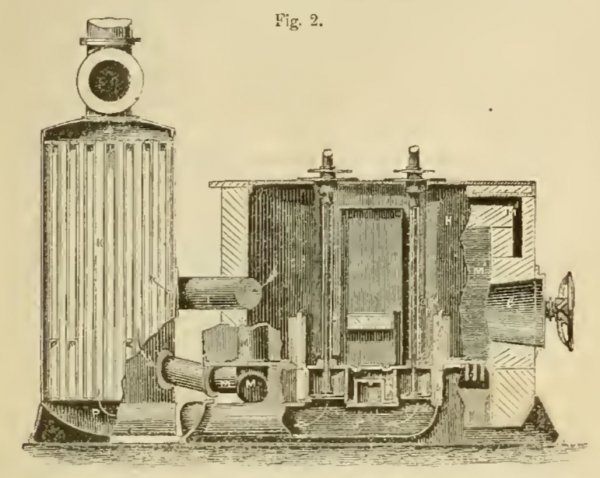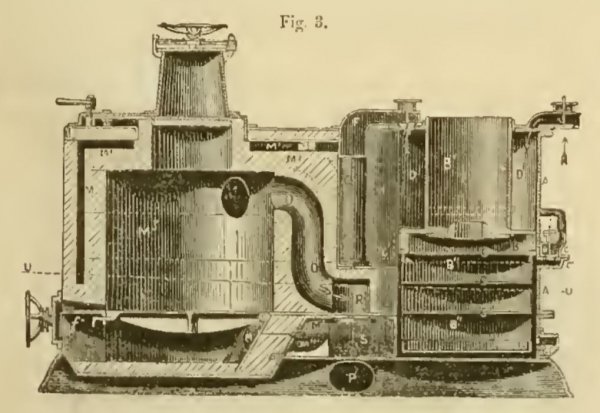Shaw's furnace air engine
Source: an article from the Practical Mechanic's Journal, Vol 3, January 1st, 1868.
Title: Paris Exhibition. Notices of some specially interesting objects, etc. - Shaw's Hot-Air Engine
In an open shed in the neighbourhood of the British boilers at the Champ de Mars there was a small but somewhat noisy engine that attracted a good deal of attention. This is the hot-air engine of Mr. Philander Shaw, of Boston, U.S., and it is probably the most successful attempt that has yet been made to employ hot air as a motive power.
It occupies a space of about 8 feet square (approx. .75 m2), is of the indicated power of twenty horses, and it was employed for the purposes of the Exhibition in turning a screw in a tank of water.
The inventor states that his engine requires very little attention compared with a steam-engine, and that its consumption of fuel per horse-power per hour is less than that of the best class of steam-engines. Instead of heating the air in a receiver, it is heated in the furnace itself; there is therefore much less loss of heat and the engine is got to work much sooner.
The accompanying cuts will show our readers the construction of the engine.

Fig. 1 is a sectional plan through u u, in fig. 3.
Fig. 2 is a longitudinal section through w, in fig. 1 ;
and fig. 3 is a section through WW, in fig. 1.
A is one of the cylinders ;
B, the piston ;
b', the piston trunk ;
b", the piston extension;
C C C, diaphragm plates;
D, annular space surrounding b', which serves for the air pump ;
E, inlet valve for cold air ;
F, discharge valve for same ;
G, pipe leading into the hot-air valve ;
H, cold-air chamber ;
I, pipe from same to the auxiliary heater ;
K, auxiliary heater ;
L, pipe leading from the auxiliary heater to M ;
M, pipe conducting cold air into the ash pit and air chamber,
m', surrounding the combustion chamber, M3 ;
m", damper controlling the passage of air into the furnace;
nnn, small apertures through which the air enters the combustion chamber ;
o, pipe conducting heated air from the combustion chamber to the cylinder;

p, exhaust pipe conducting expanded air from the cylinder, A, into the tubes of the auxiliary heater;
n, induction valve for hot air ;
s, eduction valve for same ;
a, fuel receiver for supplying the fire while the engine is in motion ;
b, circulating passage admitting oold air round the valve seats;
c, valve admitting cold air in the chamber, c', surrounding the piston;
d, vacuum valve;
e, furnace door ;
f, ash door.
The single-headed arrows in fig. 1 indicate the course of the air to the furnace, and the double-headed arrows indicate its course on leaving the furnace.

The action of the engine is as follows:
After the fire has been kindled and the engine sufficiently heated to expand the air, the doors are all closed air tight, and in a few seconds the expansion of the products of combustion and the heating of the air inclosed in the furnace will give the pressure required to start the engine by merely turning the crank over the dead centre.
Suppose the piston, B, to commence its downward stroke, the pressure from without will open the valve, E, filling the air pump, D, with cold air; the return stroke of the piston, b, forces this supply of air through the valve, v, and the pipe, G, into the hotair valve, n, and cold chamber, n ; from thence it passes by the pipe, I, to the auxiliary heater, k, into the space surrounding the tubes, where it receives the heat imparted to the tubes by the exhaust air.
From the auxiliary heater the air passes through the pipes, L and M, the latter of which opens at one end into the ash pit and at the other into the air space, m', surrounding the combustion chamber, M3 , where it receives the final heating, and is then admitted by the hot-air passage, o, and hot-air valve, R, to the cylinder, A, and after actuating the piston is discharged by the exhaust valve, s, and the exhaust passage, P, through the tubes of the auxiliary heater out of the chimney.